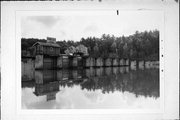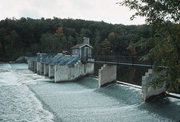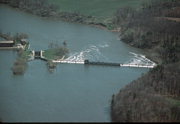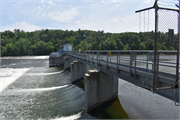Property Record
LITTLE KAUKAUNA LOCK AND DAM
Architecture and History Inventory
| Historic Name: | Little Kaukauna Dam |
|---|---|
| Other Name: | Little Kaukauna Dam |
| Contributing: | Yes |
| Reference Number: | 49684 |
| Location (Address): | LITTLE KAUKAUNA LOCK AND DAM |
|---|---|
| County: | Brown |
| City: | |
| Township/Village: | Rockland |
| Unincorporated Community: | |
| Town: | 22 |
| Range: | 20 |
| Direction: | E |
| Section: | 18 |
| Quarter Section: | SW |
| Quarter/Quarter Section: | NE |
| Year Built: | 1925 |
|---|---|
| Additions: | |
| Survey Date: | 19882023 |
| Historic Use: | dam/lock |
| Architectural Style: | NA (unknown or not a building) |
| Structural System: | |
| Wall Material: | Concrete |
| Architect: | |
| Other Buildings On Site: | |
| Demolished?: | No |
| Demolished Date: |
| National/State Register Listing Name: | Little Kaukauna Lock and Dam Historic District |
|---|---|
| National Register Listing Date: | 12/7/1993 |
| National Register Multiple Property Name: | Waterway Resources of the Lower Fox River |
| Additional Information: | Photo code #1: FCS 3/34. This dam is a concrete structure with an overall length of 587.7 feet. Completed in 1927, it is located immediately to the south of the very west end of the short canal segment associated with the site. The dame creates the pool that floods the canal in which the little Kaukauna lock is located. It is generally oriented on the NNW/SSE axis. Anchored to pilings driven into the river's bottom, the dam consists of three sections. The northern section, which is 167 feet, and the southern section, which is 215.7 feet, are concrete spillways. The spillways are forty-seven feet wide, and fix the maximum level of the pool the dam creates at 592.8 feet above sea level (it maintains about a seven foot head). The middle portion each of which contains a fourteen by twenty foot, steel Tainter gate. The gates are operated by a "crab," a small electricaly operated mechanism that moves from gate to gate on a track. The "crab" contains a wench, to which the chain on each end of the gate is attached. As the wench is activated, the chain is taken accordingly. A steel catwalk, which facilitates inspections and maintenance, extends the length of the dam. Placed atop the dam is a single story front gabled shed that was erected to shelter the electric "crab." Spanning the abutments adjacent to the northern most tainter gate, the lift house is reached by a metal catwalk that then passes it on the upstream side. It is clad with drop siding, roofed with asphalt shingles, and has walls bounded with pilasters strips. The single window in each side wall and the panelled door at the right of the lockside endwall have simple surrounds. A pair of heavy wooden doors in the opposite endwall swing out to allow passage of the "crab" to whatever gate must be adjusted. This small building has a remarkably heavy frame. The side wall sills are the bottom chord of a triangular, internal truss, above and below which the studs are pieced. |
|---|---|
| Bibliographic References: | (A) Annual Report of the Chief of Engineers, 1927: Extract - Report Upon the Improvement of Rivers and Harbors in the Milwaukee, Wis., District (Washington, D.C.: Government Printing Office, 1927), 1299. |
| Wisconsin Architecture and History Inventory, State Historic Preservation Office, Wisconsin Historical Society, Madison, Wisconsin |




